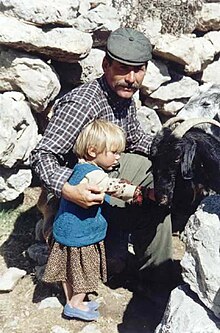Yörüks
The English used in this article or section may not be easy for everybody to understand. (July 2023) |
The Yörüks, also Yuruks or Yorouks (Turkish: Yörükler; Greek: Γιουρούκοι, Youroúkoi; Bulgarian: юруци; Macedonian: Јуруци, Juruci), are a Turkish ethnic subgroup of Oghuz descent,[4][5] some of whom are nomadic, primarily inhabiting the mountains of Anatolia, and partly in the Balkan peninsula.[6] On the Balkans Yörüks are distributed over a wide area from southern Serbia, North Macedonia[7] parts of Bulgaria, north to Larissa in Thessaly and southern Thrace.[8][9] Their name derives from the Turkish verb yürü- (yürümek in infinitive), which means "to walk", with the word yörük or yürük designating "those who walk on the hindlegs, walkers".[10][11] The Yörüks were under the Yörük Sanjak, (Turkish: Yörük Sancağı) which was not a territorial unit like the other sanjaks, but a separate organisational unit of the Ottoman Empire.[12][13]
 A Yörük father with his daughter, Antalya | |
| Total population | |
|---|---|
| apprx. 3 million | |
| Regions with significant populations | |
| Anatolia, Balkans, East Thrace, Aegean Sea | |
| >1,000,000[1][2] (2011) | |
| 588,318 (2011 census)—1,500,000[3] (2019) | |
| 150,000[3] (2019) | |
| 150,000[3] (2019) | |
| 80,000[3] (2019) | |
| 27,000[3] (2011) | |
| Languages | |
| Turkish | |
| Religion | |
| Islam (Sunnism, Alevism), Bektashi, Tengrisim | |
| Related ethnic groups | |
| Turkish people and other Turkic peoples | |
Yörüks was settled in the Balkan especially in North Macedonia and the Amuca tribe in East Thrace, a subgroup of the Yörüks, at the time of Ottoman Empire, the yörük move into the Balkan mountains with their herds of sheep, Cows and goats, they live there on the alp called Yayla in Turkish, they make cheese from sheep and goat and cows Milk. Yörüks have preserved ancient turkish traditions such as Camel wrestling[14] and Turkish Oil Wrestling of Men.[15] According to some, those tribes residing in the east of the Kızılırmak river are called Turkmen people and those in the west Yörük. Both terms were used together in Ottoman sources for Dulkadirli Turkmens living in Maraş and its surroundings.[16] The ethnohistorical terms Turcoman and Turkmen are used synonymously in literature to designate Yörük ancestry.[5] Today they live mostly in houses in the valleys and plains and have preserved fair hair and a fair complexion, and blue or greyish-blue eyes of their Oghuz ancestors.[17][18][19] They hold many of their Pre-Islamic, old Tengrism culture in Lifestyle,[20] The Boys got a big Sünnet-celebration, and Yörük Festival is hold in Turkey at differet Places,[21]. The majority now are settled but some live a semi-nomadic lifestyle. Yörük's Ancestry are proud of there Heritage and Background. There are several Yörük tribes. Generally Yörüks hold strictly Endogamy marriages.[22]
References
change- ↑ "Area Handbook for the Republic of Turkey", Volume 550, Issue 80, Thomas Duval Roberts, American University (Washington, D.C.). Foreign Area Studies. U.S. Government Printing Office, 1970. Page 74.
- ↑ Michaël Thevenin (2011): "Kurdish Transhumance: Pastoral practices in South-east Turkey". Springer: Pastoralism Research Policy and Practice (1), Social Anthropology, URMIS Paris 7, DOI: 10.1186/2041-7136-1-23 page 21.
- ↑ 3.0 3.1 3.2 3.3 3.4 Açık, F. ve Yavuz R. İ. (2019). “Balkanlarda Öğreticilerin Gözünden Türkçe Öğretimi” ("Teaching Turkish from the Perspective ofTeachers in the Balkans") Archived 2021-06-30 at the Wayback Machine. Turkish World Journal of Language and Literature, Issue: 48 (Autumn 2019) - Ankara, pp. 299-326. DOI: 10.24155/tdk.2019.122.
- ↑ Vakalopoulos, Apostolos Euangelou. " Origins of the Greek Nation: The Byzantine Period, 1204-1461". Rutgers University Press, 1970. web link, p. 163, p. 330
- ↑ 5.0 5.1 Gelekçi, Cahit (2004). Türk Kültüründe Oğuz-Türkmen-Yörük Kavramları. Türkiyat Araştırmaları Dergisi, Güz 2004, Issue 1 ISSN 1305-5992
- ↑ A. Georgoudis, A. Rosati, C. Mosconi. Animal production and natural resources utilisation in the Mediterranean mountain areas. Wageningen Academic Publishers, 2 Aug 2005, page 621-622.
- ↑ Evans, Thammy; Briggs, Philip (6 June 2019). North Macedonia. Bradt Travel Guides. ISBN 9781784770846.
- ↑ Svanberg, Ingvar: The turkish-speaking ethnic groups in Europe (pp.65-128) in Europa ethnica, volume 41. W. Braumüller, 1984, p.68.
- ↑ A Bibliography of the Turkish-speaking Tribal Yörüks, by Ingvar Svanberg (Uppsala). Materialia Turcica, Volumes 5-8. Studienverlag Brockmeyer, 1981, page 21.
- ↑ Turkish Language Association - TDK Online Dictionary. Yorouk Archived April 4, 2009, at the Wayback Machine, yorouk Archived April 4, 2009, at the Wayback Machine (in Turkish)
- ↑ "yuruk." Webster's Third New International Dictionary, Unabridged. Merriam-Webster. 2002.
- ↑ Сима Ћирковић; Раде Михаљчић (1999). Лексикон српског средњег века. Knowledge. p. 645. ISBN 9788683233014. Retrieved 23 March 2013.
- ↑ Aleksandar Matkovski (1983). Otpor na Makedonija vo vremeto na turskoto vladeenje. Misla. p. 372. Retrieved 23 March 2013.
- ↑ "Camel wrestling festival: A legacy of Turkey's Yörük culture". Daily Sabah. 18 January 2022.
- ↑ "Orientation - Yörük".
- ↑ Solak, İbrahim. XVI. Yüzyılda Maraş ve Çevresinde Dulkadirli Türkmenleri.
- ↑ Yusuf Durul: Flat-woven rugs made by "Yürüks". Ak Yayınları, 1977, page 60 cited: "The Turcomans, on the other hand, are of medium height, with fair hair and a fair complexion, and blue or greyish-blue eyes. They generally live in houses in the valleys and plains."
- ↑ İbrahim Aksu, "An Onomastic Study of Turkish Family Names, Their Origins, and Related Matters." 2005 , page 50 cited: "The yörük tribes were a peaceful race with fair complexions and fine physique , known as great camel breeders."
- ↑ Insight Guides Turkey - Apa Publications (UK) Limited, 2015 cited: "Nomads (Yörüks) - Thought to be descendants of the Oguz Turkic tribe, many have preserved the fair complexion and green eyes of their ancestors;"
- ↑ Shaimerdinova, N. (2022). "Tengrism in the life of Turkic peoples". Religion and State in the Altaic World. pp. 177–182. doi:10.1515/9783110730562-016. ISBN 9783110730562.
- ↑ http://yorkam.akdeniz.edu.tr/wp-content/uploads/2019/12/7.pdf
- ↑ "Yörük - the nomads of Turkey - Fethiye Times". Archived from the original on 2022-12-11. Retrieved 2022-12-11.